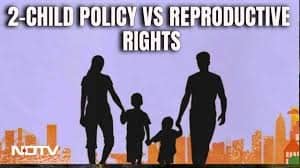
India’s population has been a hot topic for years, and with over 1.4 billion people, it’s no surprise why. The country’s rapid growth has driven both progress and problems. Sure, there’s been some economic development, but it’s also led to overpopulation, resource strain, and environmental issues. Now, there’s talk of a two-child policy as a solution, but is it the fix India needs, or is it a serious violation of citizens’ rights? Let’s dive in and break it down.
Why Population Control Matters in India
India’s explosive population growth is causing big problems in various sectors. From education and healthcare to jobs and infrastructure, everything is getting strained. According to the UN, India is expected to overtake China as the most populous country by 2027—just a few years from now. That means things will get even more complicated.
- Strained Resources: We’re already seeing shortages in food, water, housing, and other basic needs. With more people, especially in rural areas, the demand only grows.
- Economic Pressure: India has a high dependency ratio, meaning a lot of people are dependent on a relatively smaller working-age group. This contributes to high unemployment, especially in cities.
- Environmental Impact: More people means more consumption, and India’s large population is a huge contributor to pollution and environmental damage.
What’s the Deal with the Two-Child Policy?
Some states like Uttar Pradesh, Assam, and Gujarat have already experimented with two-child policies, and now there’s talk of introducing it nationwide. So what exactly is it? Basically, it suggests that couples can have only two kids, and if they go over that, they face penalties, like restrictions on government jobs or benefits.
Key Details of the Policy
- Incentives and Penalties: Those with two or fewer children might get benefits like tax breaks or priority access to government schemes. On the flip side, if you have more than two, you could face penalties, including limits on government job opportunities or subsidies.
- Family Planning Focus: The policy emphasizes investing in family planning education, providing better access to contraceptives, and offering incentives for sterilization.
Why Some Think It Could Work
- Slowing Population Growth: The most obvious benefit is that a two-child policy could help slow down India’s population growth, easing the pressure on resources, social services, and infrastructure.
- Economic Benefits: Fewer people could mean better resource distribution, leading to less unemployment and a more productive workforce.
- Women’s Empowerment: Giving women more control over their reproductive choices can be a game-changer for their education, employment, and overall empowerment.
Global Examples
- China’s One-Child Policy: China’s one-child policy worked at first, but it led to serious social problems like an aging population and gender imbalances. Now, China’s relaxing its policy, allowing families to have two, and even three children.
- Thailand’s Family Planning Success: Thailand has had great success with voluntary family planning programs. They reduced their birth rate from 6.3 children per woman in the 1960s to 1.5 today, mainly through education and access to contraception.
But There Are Drawbacks…
- Human Rights Concerns: A two-child policy could easily be seen as an invasion of personal rights. Some worry it might lead to forced sterilizations or abortions, which are serious human rights violations.
- Impact on the Poor: Poorer sections of society, particularly in rural areas, could have trouble accessing family planning resources, making the policy unevenly enforced. This might disproportionately affect marginalized groups, especially women in more conservative regions.
- The Aging Issue: The biggest problem with a two-child policy is that it could result in an aging population, similar to what China’s facing now. Fewer children means fewer workers to support the elderly, which could cause a financial crisis later on.
- Gender Imbalance: Given India’s cultural preference for male children, a strict two-child policy might worsen gender imbalances, possibly leading to more sex-selective abortions or infanticide.
- Cultural Sensitivities: India’s incredibly diverse cultural and religious makeup means enforcing a nationwide two-child policy might spark resistance in communities where larger families are the norm.
So, Is This the Solution?
While the two-child policy could certainly help manage India’s population growth, it’s not a one-size-fits-all solution. The policy needs to be adjusted to India’s varied needs—some states might need different approaches. Along with any law, there needs to be a focus on family planning education, better access to healthcare, and a genuine push for women’s empowerment.
Population control isn’t the only answer either. The government also needs to focus on sustainable development, better resource management, and improving citizens’ quality of life regardless of how quickly the population grows.
In the end, the two-child policy could help curb growth in India, but it’s a delicate balance. It needs to respect personal freedoms while also ensuring that the country doesn’t lose sight of broader social goals, like equality and access to resources. It’s a tricky issue that requires careful thought and planning to avoid unintended consequences.


